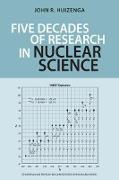- Start
- Five Decades of Research in Nuclear Science
Five Decades of Research in Nuclear Science
Angebote / Angebote:
What began as a journey into a largely unexplored region of the periodic table-rightly predicted to be a rich and fertile source of new chemical and nuclear information-quickly developed into a race for the discovery of new elements. A summary of more than forty years of work in the field, Five Decades of Research in Nuclear Science delves into the results of several projects in which John R. Huizenga played a key role.
Huizenga's career beganon the Manhattan Project and continued at the Argonne National Laboratory (ANL), where in 1949, he and his colleagues initiated a major program to produce transplutonium nuclei by multiple neutron capture in reactors. Following the first thermonuclear explosion in 1952, Huizenga participated in the discovery of the elements einsteinium and fermium found in its debris. At ANL, he studied extensively the nuclear properties and systematics of actinide nuclei.In 1967, Huizenga moved to the University of Rochester, where he investigated the excited states of actinide nuclei by reaction spectroscopy and the decay modes of actinide muonic atoms. He also made detailed studies of the energy dissipation, nucleon transfer, and microscopic time-scale associated with a new heavy-ion reaction process known as "strongly damped collisions."
John R. Huizenga is Tracy H. Harris Professor Emeritus of Chemistry and Physics at the University of Rochester.
Folgt in ca. 15 Arbeitstagen

